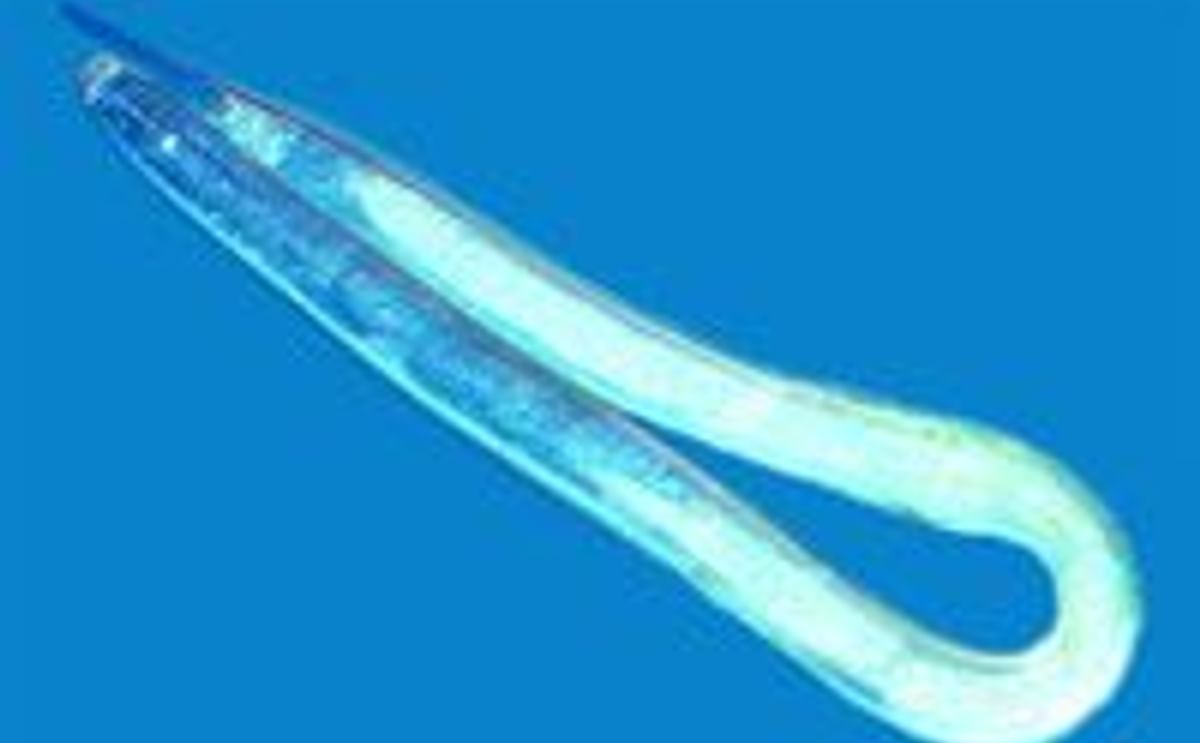The pale cyst nematode, Globodera pallida, is one bad roundworm.
Unchecked, it invades the roots of potato and other host crops to feed, obstructing the free flow of nutrients and causing stunted growth, wilted leaves, and other symptoms that can eventually kill the plant. Severe infestations in potato fields can cause yield losses of up to 80 percent. To make matters worse, female G. pallida nematodes form hard, round cysts that safeguard their eggs from predators and parasites, inhospitable conditions, or a scarcity of food. As many as 30 years may pass before the eggs hatch (cued by a signal from their plant host) to spawn a new generation of nematodes to restart the cycle of destruction.
Now, however, a team of ARS and university researchers is working to exploit those plant signals to help counter the emerging threat this pest poses to America’s $3.4 billion tuber crop. The signals are chemicals—called “egg-hatching factors”—secreted from the roots of potato and some other solanaceous plants into the soil. There, “they penetrate the cysts, stimulating the eggs inside to hatch,” explains Roy Navarre, an Agricultural Research Service plant geneticist with the Vegetable and Forage Crops Research Laboratory in Prosser, Washington. The scientists aim to use the chemicals to trick the eggs into hatching when no potato plants are present, leaving the hatchling nematodes with no host and thus no way to survive.
Leader of the Potato Cyst Nematode Pack
G. pallida, a nonnative species, was first detected in eastern Idaho in April 2006. To date, the species has been found in—and confined to—a 5-mile radius comprising 1,916 total acres in Bingham and Bonneville counties. G. pallida isn’t the first cyst nematode species to be detected in the United States on potato, though. That distinction goes to the golden nematode, G. rostochiensis, which was first reported in 1941 in New York State and is confined today to eight counties there. A third species of unknown origin, initially dubbed “atypical Globodera” and now known as G. ellingtonae, was found in small pockets on an Oregon State University (OSU) research farm near Powell Butte. Despite G. pallida’s limited geographic distribution, its U.S. presence has had far-reaching impact: closed or limited export markets, devalued farmland, regulatory restrictions, and other economic hardships. Ornamental plant nurseries in Idaho were also adversely affected immediately after the pest’s 2006 detection.
“This nematode species is really bad news,” says Navarre, whose collaborators include Chuck Brown and Rick Boydston, both with ARS at Prosser;Inga Zasada at the ARS Horticultural Crops Research Unit in Corvallis, Oregon;Mike Thornton and Louise-Marie Dandurand of the University of Idaho;and Russ Ingham, with OSU. G. pallida has been labeled a quarantine pest and targeted for eradication. Eradication efforts have involved fumigating infested fields about twice a year with one of two chemical pesticides: methyl bromide or Telone II. One problem, though, is that “the cysts are somewhat resistant to fumigation,” Navarre says. “Additional methods of control that can complement fumigation efforts would facilitate eradication” and reduce costs of implementing it on a large scale. Use of egg-hatching factors could be one such method.
Formulating a Plan of Attack
Two approaches are being explored to force the nematode eggs to hatch: The first is to use “trap crops” as the vehicle to deliver hatching factors. A trap crop would make the hatching factors and secrete them into the soil just like the host crop does, but the trap crop would be resistant to the nematode and not allow it to reproduce.
In Europe, sticky nightshade, Solanum sisymbriifolium, is being used as a trap crop. Navarre’s group was the first to establish that it stimulates eggs of the Idaho nematode population to hatch. His team also didn’t observe any reproduction of the pest. The researchers are now interested in ways of making a superior trap crop and have produced sticky nightshade with greater root mass. This will allow them to determine whether such plants secrete greater amounts of hatching factors, cover greater soil area, or secrete hatching factors deeper into the soil. Since sticky nightshade is covered in thorns, ARS plant geneticist/breeder Chuck Brown has produced lines with fewer thorns to make the plant easier to work with. The researchers are also searching for other potential trap crops that could provide an economic return to growers or not present a potential weed threat.
The second approach being explored is to use hatching factors directly, either as a soil amendment or through chemical irrigation.
“At least 10 compounds are involved,” says Navarre, citing the results of chromatography analysis, but a few key compounds might suffice for direct field application. The researchers are also exploring methods to produce large amounts of a mix of partially purified hatching factors that could be used on a commercial scale.
“We are focusing on G. pallida now, but we expect the strategy would also work on G. rostochiensis and G. ellingtonae.” he adds.
Trickery and Other Methods Explored To Vanquish Potato Cyst Nematodes

Like to receive news like this by email? Join and Subscribe!
NEW! Join Our BlueSky Channel for regular updates!
精选企业
Sponsored Content
Sponsored Content
Sponsored Content
Sponsored Content
Sponsored Content









